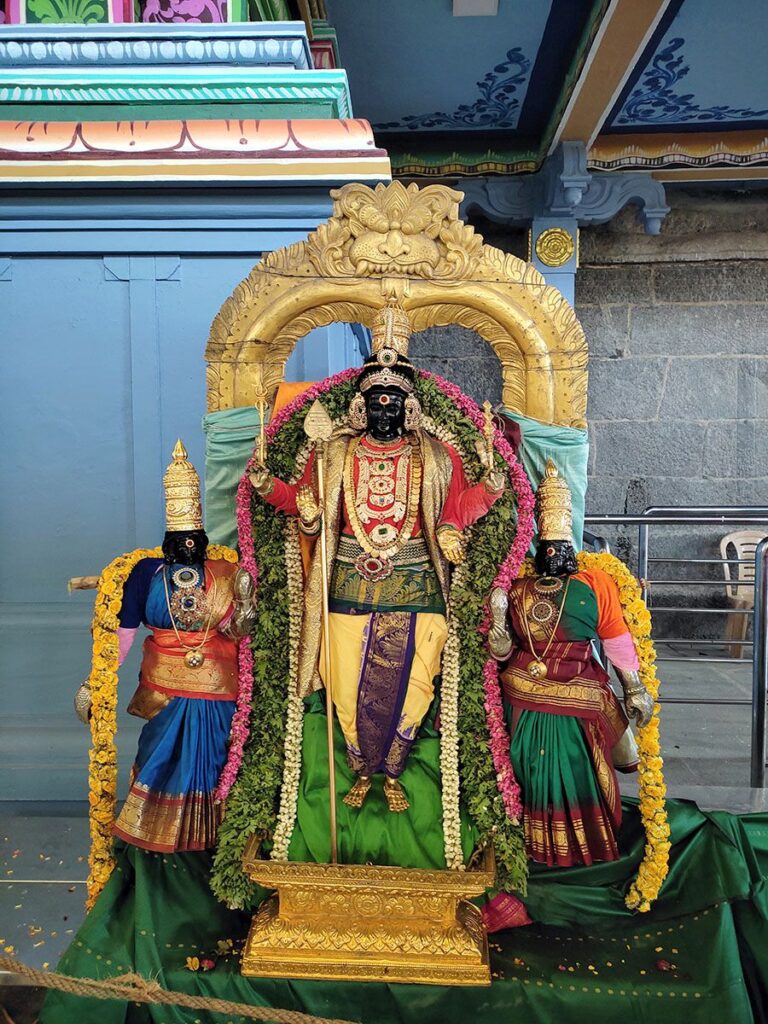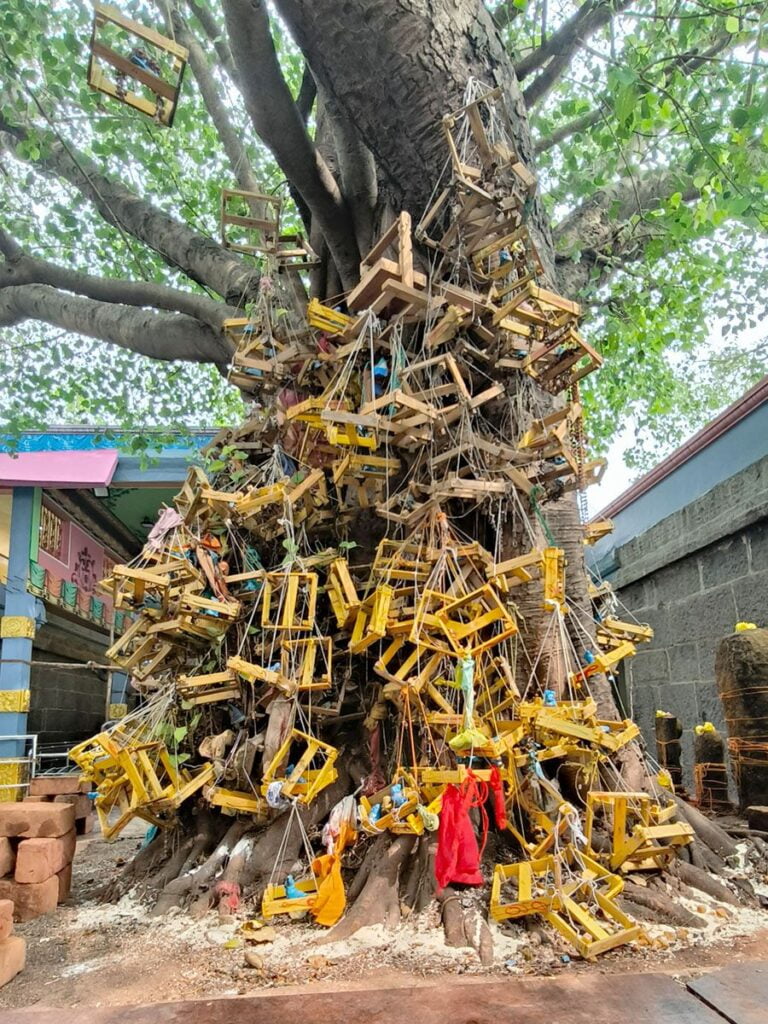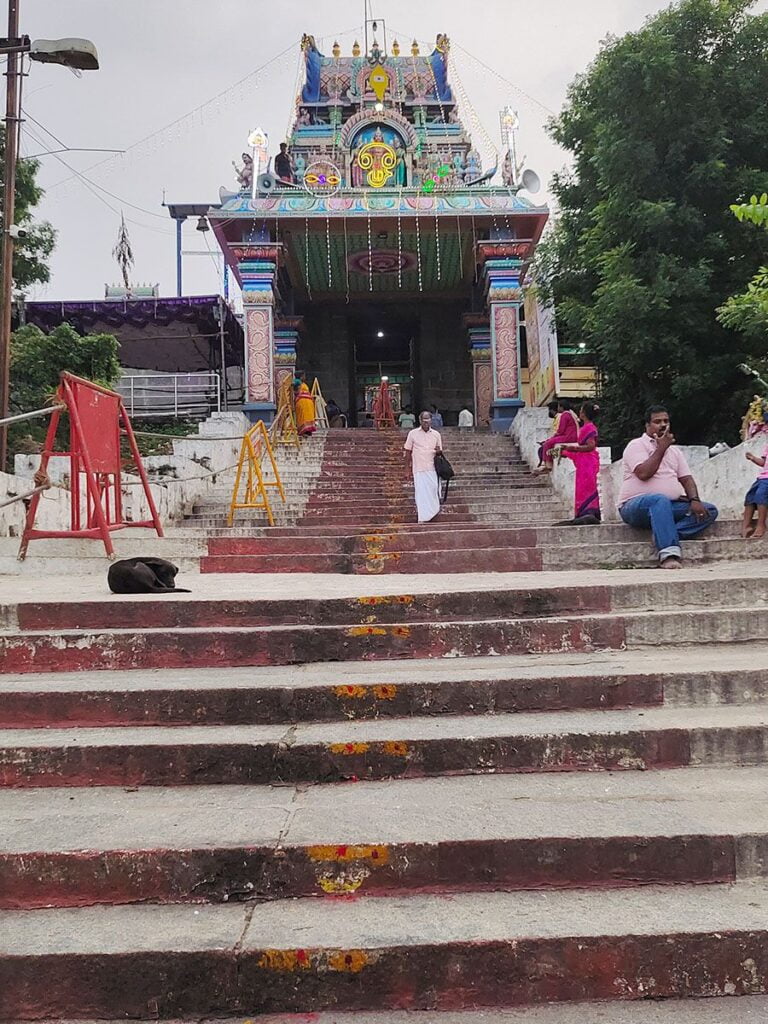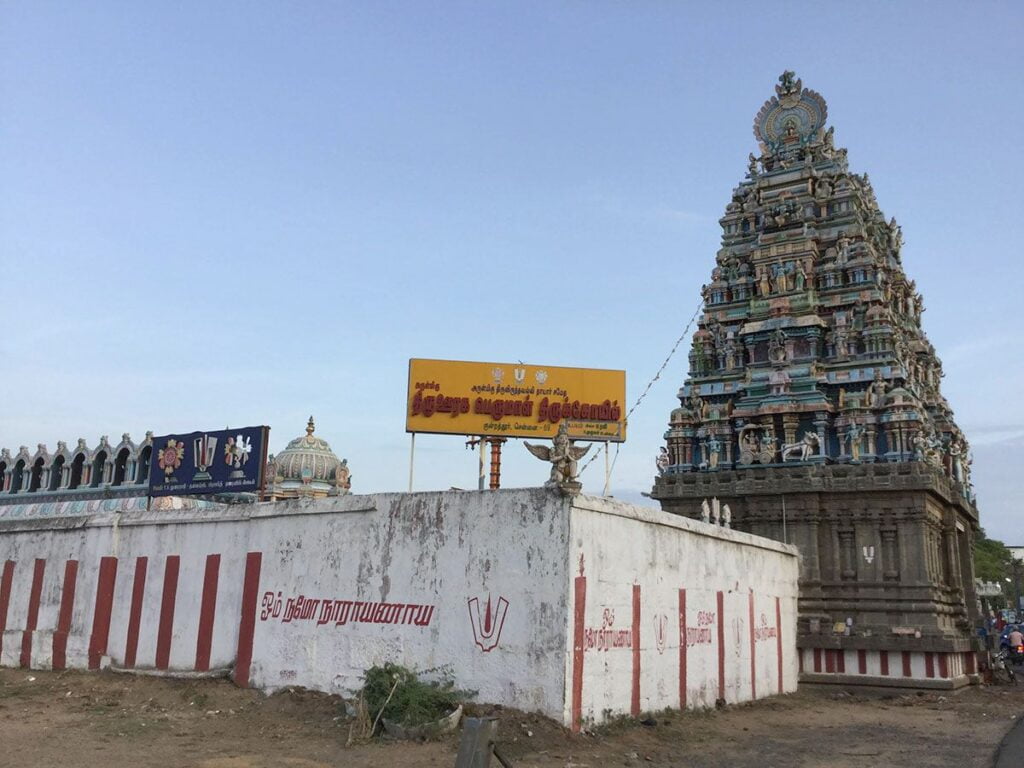Kundrathur Murugan Temple Chennai
The Kundrathur Murugan Temple is a vibrant Hindu temple dedicated to Lord Murugan, also known as Subramaniar or Shanmukha, the son of Lord Shiva and Goddess Parvati. It’s nestled atop a hillock in the town of Kundrathur, a suburb of Chennai in the Kancheepuram district of Tamil Nadu.

Contents
- 1 Legend of Kundrathur Murugan Temple:
- 2 Architecture of Kundrathur Murugan Temple:
- 3 Myths and Beliefs of Kundrathur Murugan Temple:
- 4 Significance of Kundrathur Murugan Temple:
- 5 Kundrathur Murugan Temple Timing and Rituals:
- 6 Places to visit near Kundrathur Murugan Temple:
- 7 FAQ:
- 7.0.1 Where is the Kundrathur Murugan Temple located?
- 7.0.2 How can I reach the Kundrathur Murugan Temple?
- 7.0.3 What are the opening and closing timings of the Kundrathur Murugan Temple?
- 7.0.4 What are the important festivals celebrated at the Kundrathur Murugan Temple?
- 7.0.5 What are the important features of the Kundrathur Murugan Temple?
- 7.0.6 What are the other places to visit near the Kundrathur Murugan Temple?
- 7.0.7 What are the dos and don’ts of visiting the Kundrathur Murugan Temple?
- 8 How to reach Kundrathur Murugan Temple:
- 9 Google Maps:
Kundrathur Murugan Temple History:
- The temple was most likely built by the Chola king Kulothunga Chola II in the 12th century.
- The renowned poet and saint, Sekkizhar, is believed to have been born in Kundrathur and was a regular devotee of the temple. A shrine dedicated to him is present within the temple complex.
Legend of Kundrathur Murugan Temple:
The Triumphant Journey:
One legend traces the temple’s origin to Lord Murugan’s triumphant journey. After vanquishing the demon Tarakasura in Thiruporur, Murugan set course for Tiruttani, his heart brimming with victory. During his travels, he reached the serene hillock of Kundrathur, captivated by its natural beauty and divine energy. Here, he is believed to have placed a Shiva linga, worshipped Lord Shiva, and entered a deep meditative state.
The Chola Legacy:
Impressed by the celestial aura of the location, the Chola king Kulothunga II decided to build a temple in Murugan’s honor. Thus, the majestic Kundrathur Murugan Temple came into existence, standing as a testament to the king’s devotion and Murugan’s divine grace.
The Unique Darshan:
What truly sets the Kundrathur Murugan Temple apart is its unique “darshan” experience. Here, Lord Murugan stands facing north, unlike most South Indian Murugan temples where he faces east. The temple further presents a mesmerizing spectacle through its dual goddess consorts. Devotees can witness Murugan with either Goddess Valli or Goddess Deivanai, depending on their vantage point. From one side of the sanctum, the divine couple of Murugan and Valli graces the devotees, while the other side reveals the union of Murugan and Deivanai. This unique architectural feature symbolizes the two contrasting yet complementary aspects of Murugan’s life – his warrior spirit embodied by Valli and his divine wisdom represented by Deivanai.
Beyond the Legends:
The Kundrathur Murugan Temple isn’t just a repository of captivating legends; it’s a vibrant center of faith and community. Devotees flock here from far and wide, seeking blessings for success, good health, and spiritual progress. The temple complex houses shrines dedicated to various other deities, including Lord Shiva as Kandaleeswarar, Goddess Durga, and the Navagrahas, further enriching the spiritual experience.
Read More>> Kuchanur Saneeswaran Temple Swayambu Idol

Architecture of Kundrathur Murugan Temple:
Entrance and Gopuram:
Your journey to the temple begins with a climb up 84 steps, symbolizing the path to spiritual enlightenment. Alternatively, you can drive up the hillock for easier access. As you reach the summit, a majestic five-tiered gopuram (gateway tower) adorned with intricate carvings of deities and mythical creatures greets you. This towering structure, reaching a height of around 50 feet, acts as a visual and symbolic portal to the divine realm.
Sanctum and Inner Hall:
Stepping through the gopuram, you enter the temple complex, where the sanctum sanctorum houses the main deity, Lord Murugan (also known as Subramanya). Uniquely, Lord Murugan here faces north, unlike most Murugan temples in Tamil Nadu which face east. This unusual orientation adds to the temple’s mystical aura. The sanctum sanctorum is flanked by shrines dedicated to Lord Murugan’s consorts, Goddess Valli and Goddess Devasena. Interestingly, a special feature allows devotees to view Lord Murugan with only one goddess at a time, depending on their vantage point.
Leading to the sanctum is the Ardha Mandapa, a pillared hall where devotees gather for prayers and offerings. The intricate carvings on the pillars depict Hindu mythology and celestial beings, adding to the spiritual atmosphere.
Other Notable Features:
Beyond the sanctum and hall, the temple complex houses several other noteworthy structures, each contributing to its architectural tapestry:
- 100-Pillar Hall: This spacious hall, supported by 100 intricately sculpted pillars, is believed to have been built in the 9th century. It serves as a gathering space for various religious and cultural events.
- Mayura Vahan: A majestic sculpture of Lord Murugan’s peacock, his symbolic vehicle, stands tall within the complex. This beautifully carved figure adds to the temple’s artistic charm.
- Sri Saravana Poigai: A serene temple tank known as the Sri Saravana Poigai provides a tranquil space for reflection and rejuvenation. Devotees can take a dip in the sacred waters, seeking blessings and purification.
Unique Architectural Elements:
Chola Influences: The temple showcases the characteristic features of Chola architecture, including pyramidal towers, intricately carved pillars, and vibrant murals.
Sculptural Prowess: The temple walls and pillars are adorned with exquisite sculptures depicting deities, mythical creatures, and floral motifs, showcasing the craftsmanship of ancient artisans.
Harmony with Nature: The temple’s serene setting atop the hillock, surrounded by lush greenery, creates a sense of harmony with nature, further enhancing the spiritual experience.
Read More>> 2000 yrs Om Shakthi Temple Melmaruvathur

Myths and Beliefs of Kundrathur Murugan Temple:
The Legend of Murugan’s Rest:
- Hindu mythology tells the story of Murugan, the son of Lord Shiva and Parvati, traveling from Tiruporur to Tiruttani. On his way, he stumbled upon a small hillock and decided to rest there for a few days.
- This hillock is believed to be the exact location of the present-day Kundrathur Murugan Temple.
- While resting, Murugan is said to have made a Shiva linga and worshipped it every day.
The Battle with Tharagasuran:
- Before reaching Kundrathur, Murugan had fought a fierce battle with an asura named Tharagasuran. He emerged victorious but desired peace and tranquility.
- The serenity of the hillock and the presence of the Shiva linga is said to have helped Murugan find the calm he sought.
The Unique Direction of Murugan:
- Unlike most Murugan temples in Tamil Nadu, where the deity faces east, the Murugan in Kundrathur faces north.
- This unique north-facing direction is believed to signify Murugan’s blessings for the city of Thanjavur, which lies to the north.
- The temple is also known as “South Thanigai” because of this unusual orientation.
The Two Goddesses:
- Murugan is typically accompanied by two goddesses, Valli and Devasena. However, in Kundrathur, devotees can only see Murugan with one goddess at a time.
- This phenomenon is attributed to the belief that Murugan grants the specific wishes of devotees who pray to him with a single-minded focus.
The 84 Steps:
- Climbing the 84 steps to reach the temple is considered a symbolic act of purification and preparation for darshan (seeing the deity).
- The number 84 is associated with the 84 siddhars, a group of attained beings in Hindu mythology.
Read More>> Wargal Saraswathi Temple

Significance of Kundrathur Murugan Temple:
Religious Significance:
- Dedicated to Lord Murugan: It is a prominent temple dedicated to Lord Murugan, the Hindu god of war, son of Lord Shiva and Parvati, and patron deity of Tamil Nadu.
- Unique north-facing direction: It is the only Murugan temple in Tamil Nadu where the Lord faces north, towards Thanigai (present-day Thanjavur). This is attributed to a legend and adds to the temple’s mystique.
- Special darshan: The temple offers a unique “one goddess at a time” darshan (viewing) of Lord Murugan. Devotees can see him with either Goddess Valli or Deivayanai, depending on their position before the idol.
Historical Significance:
- Chola Dynasty legacy: The temple was built by the Chola king Kulothunga Chola II, showcasing the architectural and cultural heritage of the Chola era.
- Mythological connection: Legends associate the temple with Lord Murugan’s journey from Tiruporur to Tiruttanigai, adding to its spiritual importance.
Cultural Significance:
- Festivals and traditions: The temple attracts devotees throughout the year, especially during festivals like Kanda Sashti Kavady and Thai Pusam. These festivals feature vibrant processions, dances, and rituals, showcasing Tamil culture and devotion.
- Local landmark: The temple stands atop a small hill, offering panoramic views of the surrounding area. It is a popular pilgrimage destination and a beloved landmark for the local community.
Read More>> Arupadai veedu | Six Abodes of Lord Murugan

Kundrathur Murugan Temple Timing and Rituals:
The Kundrathur Murugan Temple, dedicated to Lord Murugan, the son of Lord Shiva and Parvati, is open from 6:00 AM to 1:00 PM and 3:30 PM to 8:30 PM on all days of the week, including Sundays. However, it’s important to note that these timings might change slightly during festivals and special occasions.
Here are some of the important rituals performed at the temple:
- Abhishekam: This is a ritualistic bath for the deity, performed with milk, honey, ghee, and other sacred substances. It is believed to cleanse the idol and bring blessings to the devotees.
- Archana: This is a prayer offered to the deity with flowers, incense, and chanting of mantras. Devotees can request the priests to perform archana for specific purposes, such as seeking blessings for good health, prosperity, or success.
- Deeparadanai: This is the waving of lamps before the deity. It is a way of offering light and expressing devotion.
- Darshan: This is the act of seeing the deity. Devotees can stand in line and get a glimpse of the idol.
Festivals:
- Vaikasi Visakham: This festival is celebrated in May-June to mark the birth of Lord Murugan.
- Skanda Sashti: This is a six-day festival celebrated in October-November to commemorate Lord Murugan’s victory over the demon Surapadman.
- Thirukarthikai: This festival is celebrated on the full moon day of the Tamil month of Kartikai (November-December) to honor Lord Murugan.
- Tamil and English New Year: Both the Tamil and English New Year are celebrated at the temple with special pujas and prayers.
- Thai Poosam: This festival is celebrated in January-February to mark Lord Murugan’s marriage to Deivanai.
- Thai Pongal: This harvest festival is celebrated in January with special offerings made to Lord Murugan.
Read More>> Subramanya Swamy Temple Thiruparankunram

Places to visit near Kundrathur Murugan Temple:
- Chennai (approximately 25 km away): Explore the capital city of Tamil Nadu, known for its cultural heritage, temples, beaches, and modern amenities. Some notable places include Marina Beach, Kapaleeshwarar Temple, Fort St. George, and the Government Museum.
- Kanchipuram (approximately 70 km away): Known as the “City of a Thousand Temples,” Kanchipuram is famous for its silk sarees and ancient temples. Visit Ekambareswarar Temple, Kailasanathar Temple, and Varadharaja Perumal Temple.
- Mahabalipuram (approximately 60 km away): A UNESCO World Heritage Site, Mahabalipuram is known for its ancient rock-cut temples and sculptures. Shore Temple, Pancha Rathas, and Arjuna’s Penance are must-visit attractions.
- Vedanthangal Bird Sanctuary (approximately 80 km away): If you enjoy birdwatching, visit Vedanthangal Bird Sanctuary, one of the oldest water bird sanctuaries in India. It is home to various migratory and resident bird species.
- Sriperumbudur (approximately 35 km away): Visit the birthplace of Sri Ramanuja, a prominent Hindu theologian, and the Rajiv Gandhi Memorial, dedicated to the former Prime Minister of India.
- Kovalam Beach (approximately 40 km away): Relax at Kovalam Beach, known for its serene ambiance and clean sands. It’s a popular destination for a day trip or a weekend getaway.
FAQ:
Where is the Kundrathur Murugan Temple located?
The Kundrathur Murugan Temple is located in the town of Kundrathur, in the Kanchipuram district of Tamil Nadu, India. It is approximately 15 kilometers from the city of Chennai.
How can I reach the Kundrathur Murugan Temple?
The temple is easily accessible by road. There are direct buses from Chennai to Kundrathur. You can also take a taxi or an autorickshaw.
What are the opening and closing timings of the Kundrathur Murugan Temple?
The temple is open from 5:00 AM to 1:00 PM and 3:00 PM to 9:00 PM.
What are the important festivals celebrated at the Kundrathur Murugan Temple?
The most important festivals celebrated at the temple are:
- Skanda Shashti: This festival is celebrated in the month of Karthigai (November-December). It is a nine-day festival dedicated to Lord Murugan.
- Skanda Shasti Homam: This is a special puja performed on the day of Skanda Shashti. It is believed to bring blessings of Lord Murugan.
- Thaipoosam: This festival is celebrated in the month of Thai (January-February). It is a ten-day festival dedicated to Lord Murugan.
- Aadi Pooram: This festival is celebrated in the month of Aadi (July-August). It is a nine-day festival dedicated to Lord Murugan.
What are the important features of the Kundrathur Murugan Temple?
The temple is located on a small hillock. The main deity of the temple is Lord Murugan, who is depicted standing in a north-facing direction. This is a unique feature of the temple, as most Murugan temples in Tamil Nadu have Lord Murugan facing the east.
The temple complex also houses shrines dedicated to Goddess Valli, Goddess Deivayanai, and Lord Shiva. There is also a pond located within the temple complex.
What are the other places to visit near the Kundrathur Murugan Temple?
There are a few other places to visit near the Kundrathur Murugan Temple, including:
- Mangadu Veeran Temple: This temple is dedicated to Mangadu Veeran, a local folk hero.
- Kundrathur Vishnu Temple: This temple is dedicated to Lord Vishnu.
- Kundrathur Fort: This fort was built by the Pallava dynasty.
What are the dos and don’ts of visiting the Kundrathur Murugan Temple?
Here are some dos and don’ts of visiting the Kundrathur Murugan Temple:
Dos:
- Dress modestly.
- Remove your shoes before entering the temple.
- Offer prayers to the deities.
- Donate to the temple.
Don’ts:
- Speak loudly or make noise inside the temple.
- Touch the deities or the temple idols.
- Eat or drink inside the temple.
How to reach Kundrathur Murugan Temple:
- By Air:
- The nearest airport is Chennai International Airport.
- From the airport, you can hire a taxi or use other modes of transportation to reach Kundrathur.
- By Train:
- The nearest major railway station is Chennai Central.
- From Chennai Central, you can hire a taxi or take a local train to reach Kundrathur.
- By Road:
- Kundrathur is well-connected by road, and you can reach there by car, taxi, or bus.
- If you are in Chennai, you can use navigation apps or ask locals for directions to Kundrathur Murugan Temple.
- Local Transportation:
- Once you reach Kundrathur, you can hire a local taxi or auto-rickshaw to reach the temple.
- If you’re using public transportation, inquire about local bus routes that pass through or near Kundrathur.
